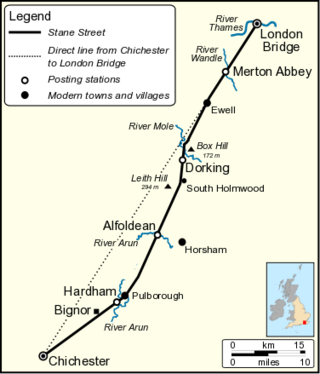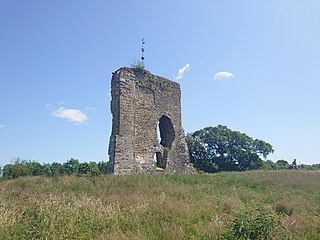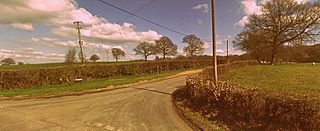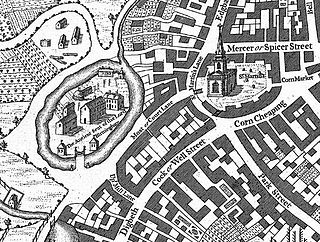Related Research Articles

Bodiam Castle is a 14th-century moated castle near Robertsbridge in East Sussex, England. It was built in 1385 by Sir Edward Dalyngrigge, a former knight of Edward III, with the permission of Richard II, ostensibly to defend the area against French invasion during the Hundred Years' War. Of quadrangular plan, Bodiam Castle has no keep, having its various chambers built around the outer defensive walls and inner courts. Its corners and entrance are marked by towers, and topped by crenellations. Its structure, details and situation in an artificial watery landscape indicate that display was an important aspect of the castle's design as well as defence. It was the home of the Dalyngrigge family and the centre of the manor of Bodiam.

Farley Green is a small hamlet of Albury in the Greensand Ridge where it forms the south of the Surrey Hills AONB, to the south east of Guildford.

Baconsthorpe Castle, historically known as Baconsthorpe Hall, is a ruined, fortified manor house near the village of Baconsthorpe, Norfolk, England. It was established in the 15th century on the site of a former manor hall, probably by John Heydon I and his father, William. John was an ambitious lawyer with many enemies and built a tall, fortified house, but his descendants became wealthy sheep farmers, and being less worried about attack, developed the property into a more elegant, courtyard house, complete with a nearby deer park.

Bodiam is a small village and civil parish in the Rother District of East Sussex, England. It lies in the valley of the River Rother, near to the villages of Sandhurst and Ewhurst Green.

Stane Street is the modern name of the 91 km-long (57 mi) Roman road in southern England that linked Londinium (London) to Noviomagus Reginorum (Chichester). The exact date of construction is uncertain; however, on the basis of archaeological artefacts discovered along the route, it was in use by 70 AD and may have been built in the first decade of the Roman occupation of Britain.

Coolham is a small village in the civil parish of Shipley and the Horsham District of West Sussex, England. It is located at the crossroads of the A272 and B2139 roads 2.8 miles (4.6 km) southeast of Billingshurst.

Pevensey Castle is a medieval castle and former Roman Saxon Shore fort at Pevensey in the English county of East Sussex. The site is a scheduled monument in the care of English Heritage and is open to visitors. Built around 290 AD and known to the Romans as Anderitum, the fort appears to have been the base for a fleet called the Classis Anderidaensis. The reasons for its construction are unclear; long thought to have been part of a Roman defensive system to guard the British and Gallic coasts against Saxon pirates, it has more recently been suggested that Anderitum and the other Saxon Shore forts were built by a usurper in an ultimately unsuccessful attempt to prevent Rome from reimposing its control over Britain.

Weeting Castle is a ruined, medieval manor house near the village of Weeting in Norfolk, England. It was built around 1180 by Hugh de Plais, and comprised a three-storey tower, a substantial hall, and a service block, with a separate kitchen positioned near the house. A moat was later dug around the site in the 13th century. The house was not fortified, although it drew on architectural features typically found in castles of the period, and instead formed a very large, high-status domestic dwelling. It was probably intended to resemble the hall at Castle Acre Castle, owned by Hugh's feudal lord, Hamelin de Warenne.

Nuthurst is a village and civil parish in the Horsham district of West Sussex, England. The north of the parish borders Horsham town, with Nuthurst village 3 miles (5 km) south from the border. Within the parish is the estate and largely 19th-century country house of Sedgwick Park.

The medieval Knepp Castle is to the west of the village of West Grinstead, West Sussex, England near the River Adur and the A24.

Graylands is a hamlet in the Horsham district of West Sussex, England. The largely rural hamlet is located north of Holbrook beyond the A264. It is bordered by Langhurstwood Road to the west, Old Holbrook to the east, and Green Lane on its northern perimeter.

Bury Castle was an early medieval moated manor house in Bury, Lancashire. Its remains are listed as a Scheduled Ancient Monument. The manor house was built by Sir Thomas Pilkington – lord of the manors of Bury and Pilkington, and an influential member of Lancashire's gentry – in 1469. He was given permission by Edward IV to:
"'build to make and to construct walls and turrets with stone, lime and sand around and below his manor house in Bury in the County of Lancaster, and to shut in the manor house with such manner of walls and turrets; also to embattle, crenellate and machicolate those towers."

The Birmingham Manor House or Birmingham Moat was a moated building that formed the seat of the Lord of the Manor of Birmingham, England during the Middle Ages, remaining the property of the de Birmingham family until 1536. The buildings were demolished and the moat filled-in in 1815–16, but the remains of medieval stone structures excavated in 1973–75 survive intact beneath the buildings of the Birmingham Wholesale Markets.
Thornhill Hall is a ruined medieval manor house on a moated island in Rectory Park, Thornhill, West Yorkshire, England. The ruins are listed as grade II. and the moat, with the surrounding grounds, is a scheduled monument.

Hen Gwrt,, Llantilio Crossenny, Monmouthshire is the site of a thirteenth century manor house and a sixteenth century hunting lodge. Originally constructed for the Bishops of Llandaff, it subsequently came into the possession of the Herberts of Raglan Castle. The bishops constructed a substantial manor house on the site in the thirteenth century, which was moated in the fourteenth. The building was then adapted by the Herberts to create a lodge within their extensive hunting grounds. The lodge continued in use until the slighting of Raglan Castle in the English Civil War.

Hobs Moat is a ruined 12th-century castle located to the west of Hobs Moat Road and north of Castle Lane in Olton in Solihull, England. The site is designated a scheduled ancient monument, however, only the earthworks remain above the ground level.

Pinxton Castle, Derbyshire, is a scheduled monument in Castle Wood that straddles Pinxton and South Normanton. In its designation as a scheduled monument, Historic England describes it as having been a motte and fortified manor, with a moated site and five fishponds. Unlike most of the about 6000 moated sites in England, a large, fortified enclosure surrounded the moat.
There are 912 scheduled monuments in the county of West Sussex, England. These protected sites date in some cases from the Neolithic period, and include medieval moated sites, ruined abbeys, castles, and Iron Age hillforts. In the United Kingdom, the scheduling of monuments was first initiated to ensure the preservation of "nationally important" archaeological sites and historic buildings. Protection is given to scheduled monuments under the Ancient Monuments and Archaeological Areas Act 1979.
References
- ↑ "Ruins of Sedgwick Castle, Moated site, Nuthurst - Horsham". Historic England. Retrieved 25 February 2024.
- 1 2 Mackenzie, Sir James Dixon (1896). The Castles of England: Their Story and Structure. New York: Macmillan Co. pp. 88–89. OCLC 679965266.
- 1 2 "Sedgwick Castle, Nuthurst, West Sussex". Jessop Consultancy. Retrieved 25 February 2024.
- ↑ "Sedgwick Park". Historic England. Retrieved 25 February 2024.
- 1 2 "Medieval moated site at Sedgwick Castle". Historic England. Retrieved 25 February 2024.
- 1 2 Winbolt, Samuel Edward (1925). "Sedwick Castle including Excavations 1923-4". Sussex Archaeological Collections. 66: 83–110. doi: 10.5284/1085965 – via Archaeology Data Service.
- ↑ "West Sussex HER". Heritage Gateway. Retrieved 25 February 2024.
- ↑ "Historic England Research Records: Sedgwick Castle". Heritage Gateway: Historic England. Retrieved 25 February 2024.
- ↑ "Sedgwick Park". The Gardens Trust. Retrieved 25 May 2024.